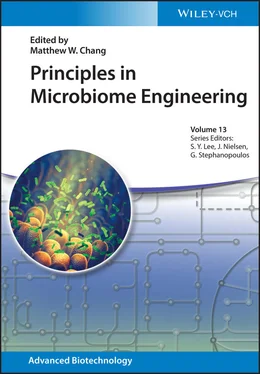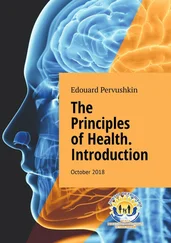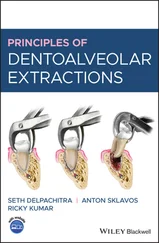Principles in Microbiome Engineering
Здесь есть возможность читать онлайн «Principles in Microbiome Engineering» — ознакомительный отрывок электронной книги совершенно бесплатно, а после прочтения отрывка купить полную версию. В некоторых случаях можно слушать аудио, скачать через торрент в формате fb2 и присутствует краткое содержание. Жанр: unrecognised, на английском языке. Описание произведения, (предисловие) а так же отзывы посетителей доступны на портале библиотеки ЛибКат.
- Название:Principles in Microbiome Engineering
- Автор:
- Жанр:
- Год:неизвестен
- ISBN:нет данных
- Рейтинг книги:5 / 5. Голосов: 1
-
Избранное:Добавить в избранное
- Отзывы:
-
Ваша оценка:
- 100
- 1
- 2
- 3
- 4
- 5
Principles in Microbiome Engineering: краткое содержание, описание и аннотация
Предлагаем к чтению аннотацию, описание, краткое содержание или предисловие (зависит от того, что написал сам автор книги «Principles in Microbiome Engineering»). Если вы не нашли необходимую информацию о книге — напишите в комментариях, мы постараемся отыскать её.
Provides an overview of the techniques and applications insight into the complex composition and interactions of microbiomes Principles in Microbiome Engineering
Principles in Microbiome Engineering
Principles in Microbiome Engineering — читать онлайн ознакомительный отрывок
Ниже представлен текст книги, разбитый по страницам. Система сохранения места последней прочитанной страницы, позволяет с удобством читать онлайн бесплатно книгу «Principles in Microbiome Engineering», без необходимости каждый раз заново искать на чём Вы остановились. Поставьте закладку, и сможете в любой момент перейти на страницу, на которой закончили чтение.
Интервал:
Закладка:
These researches are being supported by various governmental, Non‐Governmental Organizations, and private institutions, indicating the importance of the field. It is clear that the role of diet indeed is an important aspect of host health and would merit further investigation.
Acknowledgments
This work is supported by the Chinese National Key Research and Development Program (2018YFA0902604) and the Shenzhen Institutes of Advanced Technology External Funds (DWKF20190001).
References
1 1 Huss, J. (2014). Methodology and ontology in microbiome research. Biol. Theory 9 (4): 392–400.
2 2 Poliakov, E., Cooper, D.N., Stepchenkova, E.I., et al. (2015). Genetics in genomic era. Genet. Res. Int. 2015: 364960.
3 3 Turnbaugh, P.J., Ley, R.E., Hamady, M., et al. (2007). The human microbiome project. Nature 449 (7164): 804–810.
4 4 Gevers, D., Knight, R., Petrosino, J.F., et al. (2012). The human microbiome project: a community resource for the healthy human microbiome. PLoS Biol. 10 (8): e1001377.
5 5 Torres, M.P., Chakraborty, S., Souchek, J., and Batra, S.K. (2012). Mucin‐based targeted pancreatic cancer therapy. Curr. Pharm. Des. 18 (17): 2472–2481.
6 6 The Human Microbiome Project Consortium (2012). Structure, function and diversity of the healthy human microbiome. Nature 486 (7402): 207–214.
7 7 Dewhirst, F.E., Chen, T., Izard, J., et al. (2010). The human oral microbiome. J. Bacteriol. 192 (19): 5002–5017.
8 8 Zaura, E., Keijser, B.J.F., Huse, S.M., et al. (2009). Defining the healthy “core microbiome” of oral microbial communities. BMC Microbiol. 9: 259.
9 9 Moffatt, M.F. and Cookson, W.O. (2017). The lung microbiome in health and disease. Clin. Med. (Lond.) 17 (6): 525–529.
10 10 Goodrich, J.K., Waters, J.L., Poole, A.C., et al. (2014). Human genetics shape the gut microbiome. Cell 159 (4): 789–799.
11 11 Grice, E.A., Kong, H.H., Conlan, S., et al. (2009). Topographical and temporal diversity of the human skin microbiome. Science 324 (5931): 1190–1192.
12 12 Hilt, E.E., McKinley, K., Pearce, M.M., et al. (2014). Urine is not sterile: use of enhanced urine culture techniques to detect resident bacterial flora in the adult female bladder. J. Clin. Microbiol. 52 (3): 871–876.
13 13 Mameli, C., Cattaneo, C., Panelli, S., et al. (2019). Taste perception and oral microbiota are associated with obesity in children and adolescents. PLoS One 14 (9): e0221656.
14 14 Stewart, C.J., Ajami, N.J., O'Brien, J.L., et al. (2018). Temporal development of the gut microbiome in early childhood from the TEDDY study. Nature 562 (7728): 583–588.
15 15 Vatanen, T., Franzosa, E.A., Schwager, R., et al. (2018). The human gut microbiome in early‐onset type 1 diabetes from the TEDDY study. Nature 562 (7728): 589–594.
16 16 Ferretti, P., Pasolli, E., Tett, A., et al. (2018). Mother‐to‐infant microbial transmission from different body sites shapes the developing infant gut microbiome. Cell Host Microbe 24 (1): 133.e5–145.e5.
17 17 Fox, C. and Eichelberger, K.Y. (2015). Maternal microbiome and pregnancy outcomes. Fertil. Steril. 104 (6): 1358–1363.
18 18 Bik, E.M., Eckburg, P.B., Gill, S.R., et al. (2006). Molecular analysis of the bacterial microbiota in the human stomach. Proc. Natl. Acad. Sci. U.S.A. 103 (3): 732–737.
19 19 Andersson, A.F., Lindberg, M., Jakobsson, H., et al. (2008). Comparative analysis of human gut microbiota by barcoded pyrosequencing. PLoS One 3 (7): e2836.
20 20 Dorer, M.S., Talarico, S., and Salama, N.R. (2009). Helicobacter pylori's unconventional role in health and disease. PLoS Pathog. 5 (10): e1000544.
21 21 Booijink, C.C., El‐Aidy, S., Rajilić‐Stojanović, M., et al. (2010). High temporal and inter‐individual variation detected in the human ileal microbiota. Environ. Microbiol. 12 (12): 3213–3227.
22 22 Zoetendal, E.G., Raes, J., van den Bogert, B., et al. (2012). The human small intestinal microbiota is driven by rapid uptake and conversion of simple carbohydrates. ISME J. 6 (7): 1415–1426.
23 23 Collado, M.C., Donat, E., Ribes‐Koninckx, C., et al. (2009). Specific duodenal and faecal bacterial groups associated with paediatric coeliac disease. J. Clin. Pathol. 62 (3): 264–269.
24 24 Willing, B., Halfvarson, J., Dicksved, J., et al. (2009). Twin studies reveal specific imbalances in the mucosa‐associated microbiota of patients with ileal Crohn's disease. Inflamm. Bowel Dis. 15 (5): 653–660.
25 25 Nam, Y.D., Jung, M.J., Roh, S.W., et al. (2011). Comparative analysis of Korean human gut microbiota by barcoded pyrosequencing. PLoS One 6 (7): e22109.
26 26 Flint, H.J., Duncan, S.H., Scott, K.P., and Louis, P. (2007). Interactions and competition within the microbial community of the human colon: links between diet and health. Environ. Microbiol. 9 (5): 1101–1111.
27 27 Arumugam, M., Raes, J., Pelletier, E., et al. (2011). Enterotypes of the human gut microbiome. Nature 473 (7346): 174–180.
28 28 Grice, E.A. and Segre, J.A. (2011). The skin microbiome. Nat. Rev. Microbiol. 9 (4): 244–253.
29 29 Nakatsuji, T., Chiang, H., Jiang, S.B., et al. (2013). The microbiome extends to subepidermal compartments of normal skin. Nat. Commun. 4: 1431.
30 30 Selhub, E.M., Logan, A.C., and Bested, A.C. (2014). Fermented foods, microbiota, and mental health: ancient practice meets nutritional psychiatry. J. Physiol. Anthropol. 33 (1): 2.
31 31 Bassis, C.M., Tang, A.L., Young, V.B., and Pynnonen, M.A., et al. (2014). The nasal cavity microbiota of healthy adults. Microbiome 2: 27.
32 32 Ditz, B., Christenson, S., Rossen, J., et al. (2020). Sputum microbiome profiling in COPD: beyond singular pathogen detection. Thorax 75 (4): 338–344.
33 33 Segal, L.N., Alekseyenko, A.V., Clemente, J.C., et al. (2013). Enrichment of lung microbiome with supraglottic taxa is associated with increased pulmonary inflammation. Microbiome 1 (1): 19.
34 34 Charlson, E.S., Bittinger, K., Haas, A.R., et al. (2011). Topographical continuity of bacterial populations in the healthy human respiratory tract. Am. J. Respir. Crit. Care Med. 184 (8): 957–963.
35 35 Siddiqui, H., Lagersen, K., Nederbragt, A.J., et al. (2012). Alterations of microbiota in urine from women with interstitial cystitis. BMC Microbiol. 12: 205–205.
36 36 Thomas‐White, K., Brady, M., Wolfe, A.J., and Mueller, E.R. (2016). The bladder is not sterile: history and current discoveries on the urinary microbiome. Curr. Bladder Dysfunct. Rep. 11 (1): 18–24.
37 37 Aagaard, K., Ma, J., Antony, K.M., et al. (2014). The placenta harbors a unique microbiome. Sci. Transl. Med. 6 (237): 237ra65.
38 38 Ronald, A. (2002). The etiology of urinary tract infection: traditional and emerging pathogens. Am. J. Med. 113 (Suppl. 1A): 14s–19s.
39 39 Soriano, F. and Tauch, A. (2008). Microbiological and clinical features of Corynebacterium urealyticum: urinary tract stones and genomics as the Rosetta Stone. Clin. Microbiol. Infect. 14 (7): 632–643.
40 40 Lee, J.W., Shim, Y.H., and Lee, S.J. (2009). Lactobacillus colonization status in infants with urinary tract infection. Pediatr. Nephrol. 24 (1): 135–139.
41 41 Latthe, P.M., Toozs‐Hobson, P., and Gray, J. (2008). Mycoplasma and ureaplasma colonisation in women with lower urinary tract symptoms. J. Obstet. Gynaecol. 28 (5): 519–521.
42 42 Gajer, P., Brotman, R.M., Bai, G., et al. (2012). Temporal dynamics of the human vaginal microbiota. Sci. Transl. Med. 4 (132): 132ra52.
43 43 Ott, S.J., Musfeldt, M., Wenderoth, D.F., et al. (2004). Reduction in diversity of the colonic mucosa associated bacterial microflora in patients with active inflammatory bowel disease. Gut 53 (5): 685–693.
44 44 Freire, M., Moustafa, A., Harkins, D.M., et al. (2020). Longitudinal study of oral microbiome variation in twins. Sci. Rep. 10 (1): 7954.
Читать дальшеИнтервал:
Закладка:
Похожие книги на «Principles in Microbiome Engineering»
Представляем Вашему вниманию похожие книги на «Principles in Microbiome Engineering» списком для выбора. Мы отобрали схожую по названию и смыслу литературу в надежде предоставить читателям больше вариантов отыскать новые, интересные, ещё непрочитанные произведения.
Обсуждение, отзывы о книге «Principles in Microbiome Engineering» и просто собственные мнения читателей. Оставьте ваши комментарии, напишите, что Вы думаете о произведении, его смысле или главных героях. Укажите что конкретно понравилось, а что нет, и почему Вы так считаете.












